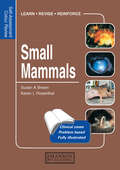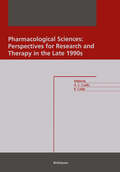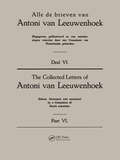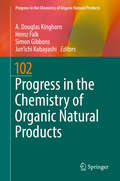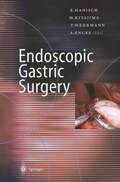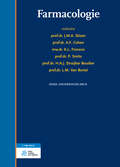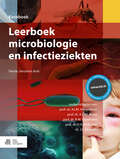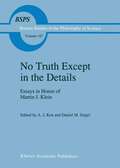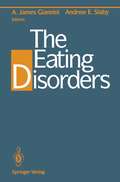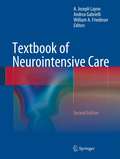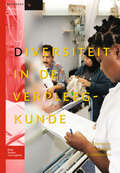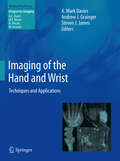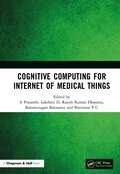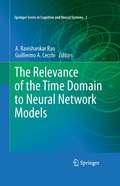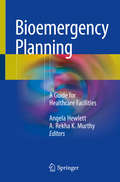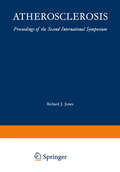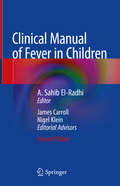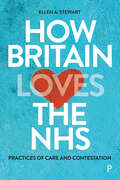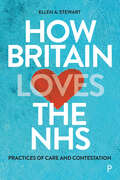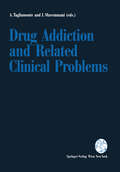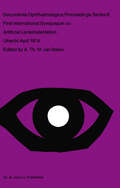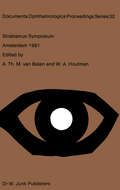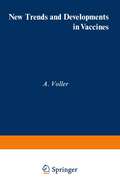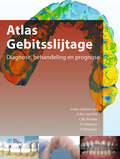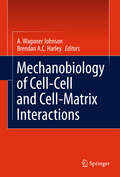- Table View
- List View
Small Mammals: Self-Assessment Color Review
by Susan A. Brown Karen L. RosenthalVeterinary practitioners are faced regularly by diseases and disorders in a large and ever increasing range of small mammalian patients. The Editors have gathered together contributions from 29 experts, who cover all aspects of medicine and surgery in small mammals including rabbits, guinea pigs, rodents, hedgehogs, ferrets, primates, squirrels, fo
Pharmacological Sciences: Perspectives for Research and Therapy in the Late 1990s
by A. C. Cuello and B. CollierThis volume arose from the scientific program of the XIIth International Congress of Pharmacology, held in Montreal, Canada, July 24-29, 1994. The scientific program included plenary lectures and symposia, in addition to poster presentations and colloquia. The abstracts of the Congress presentations were published as .supplement 1 of volume 72 by the Cana dian Journal of Physiology & Pharmacology. The Congress organizers sought a more expansive treatment of the Congress proceedings and appointed Dr. A. Claudio Cuello to coordinate preparation of the present volume; Dr. Brian Collier was chair of the scientific program committee and, thus, also collaborated on this work. The objective that we pursued was to produce a volume of reasonable size which would feature all of the plenary lectures and symposia from those authors who agreed to participate. To this end, we solicited mini reviews from plenary lecturers and asked symposia organizers to coordi nate a single short-review covering the individual topics within their event. Those who accepted this challenge are evident in this volume. We express our gratitude to these authors for doing so, and for exercising considerable ingenuity in completing their task within a reasonable time.
Collected Letters Van Leeuwenhoek, Volume 6
by A Commission of Dutch scientists.This 6th volume in a 19-volume series contains 21 letters written by van Leeuwenhoek of the perod 1686-87. The contents of the letters published here, again show the great range of subjects that occupied Van Leeuwenhoek: from sugar candy, the shape and crystal structure of diamonds, the dissolution of silver crystals in aqua fortis to gold dust from Guinea dissolved in aqua regia and the dissolution and separation of gold, silver, and copper. Every volume in the Series contains the texts in the original Dutch and an English translation. The great range of subjects studied by Van Leeuwenhoek is reflected in these letters: instruments to measure water, pulmonary diseases; experiments relating to the solution of gold and silver; salt crystals and grains of sand; botanical work, such as duckweed and germination of orange pips; description on protozoa. blood, spermatozoa and health and hygiene, for example and harmfulness of tea and coffee and the benefits of cleaning teeth.
Progress in the Chemistry of Organic Natural Products 102 (Progress in the Chemistry of Organic Natural Products #102)
by A. Douglas Douglas Kinghorn Heinz Falk Simon Gibbons Jun'Ichi KobayashiThe first contribution reviews the phytochemical, chemical, and biological literature on members of the ingenane class of diterpenoids from their first isolation in 1968 through 2015, highlighting unresolved issues both common to phorboids and specific to ingenol derivatives. The biogenesis of ingenol is discussed in the light of the Jakupovic proposal of a dissection between the formation of the macrocyclic Euphorbia diterpenoids and the phorboids, and the clinical development of ingenol mebutate is chronicled in the light of its “reverse-pharmacology” focus.The second contribution offers a comprehensive view of the chemical wealth and the taxonomic problems currently impeding chemical and biological investigations of the genus Laurencia. It addresses the botanical description and the growth and population dynamics of the genus, as well as its chemical diversity and ecological relations; the secondary metabolites as well as their sources of isolation; and finally the biological activity.
Endoscopic Gastric Surgery
by A. Encke, T. Wehrmann, M. Kitajima, E. HanischA step-by-step guide to the six most important laparoscopic procedures in gastric surgery: fundoplication, gastric banding and resection, gastro-enterostomy, gastrectomy and laparoscopic myotomy for achalasia. Written by an internationally respected group of laparoscopic general surgeons, the book includes an updated overview of indication, pathophysiology, epidemiology and diagnostics. It also covers medical and surgical therapy - both conventional and laparoscopic.
Farmacologie
by A. F. Cohen, M. Danhof, H. J. M. M. Greef, A. P. Ijzerman, M. J. H. Kenter, J. H. M. Schellens and J. M. A. SitsenFarmacologie voorziet bij uitstek in de behoefte aan een Nederlandstalig leerboek dat aansluit bij de Nederlandse geneeskunde. In dit leerboek wordt het klinisch belang van de leerstof uitgebreid toegelicht en benadrukt.Farmacologie biedt een overzicht van de belangrijkste onderwerpen uit de medische farmacologie. In de tekst zijn kaders met trefwoorden opgenomen, waardoor de student zich de termen en onderwerpen gemakkelijk eigen maakt. Bovendien wordt het geheel van de stof hierdoor overzichtelijker.Farmacologie is een medisch vakgebied dat voortdurend in beweging is en ook in de toekomst een belangrijke rol zal spelen. Daarom is in dit boek naast de leerstof ook leesstof opgenomen, waarin zowel naar de geschiedenis wordt gekeken als gespeculeerd wordt over de toekomst van de farmacologie. Het boek is geheel bijgewerkt naar de huidige stand van zaken. Nieuwe inzichten en geneesmiddelen zijn opgenomen en er is ook aandacht besteed aan weesgeneesmiddelen en monoklonale antilichamen. Het boek is uitgebreid geïllustreerd met full-color figuren van het Teaching Resource Centre van de Universiteit Leiden. Aan deze druk is een online-leeromgeving toegevoegd. De lezer kan via deze online-leeromgeving voortdurend beschikken over dit aanvullende materiaal zoals extra oefenvragen, samenvattingen en deep links met betrouwbare informatie, samengesteld door de auteurs van het boek.
Leerboek microbiologie en infectieziekten
by A. I. M. Hoepelman, A. C. M. Kroes, R. W. Sauerwein, H. A. Verbrugh and J. L. NouwenMicrobiologie en infectieziekten behandelt alle soorten infecties en alle aandachtsgebieden binnen de medische microbiologie. De indeling van dit boek is gebaseerd op klinisch relevante groepen van infectieziekten, waarbij de nadruk is gelegd op die infectieziekten die een in Nederland en Vlaanderen werkzame arts regelmatig tegenkomt. In vergelijking met de voorgaande drukken worden veel ziektebeelden uitgebreider besproken, zijn nieuwe verwekkers (bijv. het Ebola en Zika virus) opgenomen en is er een hoofdstuk over ooginfecties toegevoegd. Het inleidende hoofdstuk is geactualiseerd en op diverse plaatsen is meer aandacht besteed aan aspecten van het menselijke afweersysteem. De hoofdstukken zijn in ruime mate van illustraties voorzien en vrijwel alle ziektebeelden worden toegelicht aan de hand van patiëntencasus. Daarnaast is er een website ontwikkeld met toetsvragen en verwijzingen naar discussie over actuele onderwerpen. Microbiologie en infectieziekten is primair bedoeld als leerboek voor studenten geneeskunde en medische biologie. Daarnaast is het boek geschikt voor individuele bestudering en als naslagwerk. Aan deze geactualiseerde en uitgebreide druk hebben specialisten van alle Nederlandse geneeskundefaculteiten meegewerkt.
No Truth Except in the Details: Essays in Honor of Martin J. Klein (Boston Studies in the Philosophy and History of Science #167)
by A. J. Kox and Daniel M. SiegelBeginning with a couple of essays dealing with the experimental and mathematical foundations of physics in the work of Henry Cavendish and Joseph Fourier, the volume goes on to consider the broad areas of investigation that constituted the central foci of the development of the physics discipline in the nineteenth century: electricity and magnetism, including especially the work of Michael Faraday, William Thomson, and James Clerk Maxwell; and thermodynamics and matter theory, including the theoretical work and legacy of Josiah Willard Gibbs, some experimental work relating to thermodynamics and kinetic theory of Heinrich Hertz, and the work of Felix Seyler-Hoppe on hemoglobin in the neighboring field of biophysics/biochemistry. Moving on to the beginning of the twentieth century, a set of three articles on Albert Einstein deal with his early career and various influences on his work. Finally, a set of historiographical issues important for the history of physics are discussed, and the chronological conclusion of the volume is an article on the Solvay Conference of 1933. For physicists interested in the history of their discipline, historians and philosophers of science, and graduate students in these and related disciplines.
The Eating Disorders
by A. James Giannini and Andrew E. SlabyAs fish must swim so must man drink and eat Titus Petronius Arbiter Examine thy customs of diet Francis Bacon For John eat & drank to drive away Loves pain But all he could do he grew thinner & thinner Tho he eat & drank as much as Ten men for dinner Some said he had a Wolf in his stomach day and night William Blake To paraphrase and cast in contemporary speech observations of the Gothic-era monk Bernard of Clairvaux, the eating disorders may be viewed as a corruption of the social process, a distortion of the body image, and a perversion of bodily processes. It is this multifactorial etiology that makes the diagnosis and treatment of dietary -disorders so difficult and frustrating. Because of social demands and a distorted (body) image, men and women have perverted the simple act of eating into always painful, sometimes tragic, and occasionally deadly outcomes. The eating disorders fall into three categories. There is obesity-the overconsumption of food, and its antithesis, anorexia-the act of vol untary starvation. In true Hegelian fashion, there follows the synthesis, bulimia-the voluntary purging of overconsumed amounts of food to produce an anorectic-like countenance. As the contributing authors em phasize in their chapters, these diseases are not unique to contemporary culture. Rather they are cultural artifacts, created by both men and women, since classical antiquity. The recognition of these diseases is dependent upon recognizing a disease actually exists: that there is a distortion of the eating process.
Textbook of Neurointensive Care
by A Joseph Layon, Andrea Gabrielli and William A. FriedmanThis updated and refined new edition is the only book to provide a comprehensive approach to the intensive care of neurologically injured patients from the emergency room and ICU through the operating room and post-surgical period. It reviews neuroanatomy, neuroradiology, and neurophysiology, examines the neurological problems most frequently seen in intensive care, and describes the various types of neurosurgery. General issues are discussed, such as cardiac care, fluids and electrolytes, nutrition, and monitoring as well as more specific conditions and complications including elevated intracranial pressure, seizures, and altered mental states.
Diversiteit in de verpleegkunde (Basiswerken Verpleging en Verzorging)
by A. Kuckert and P. EsterhuizenVerpleegkundigen staan dicht bij mensen. Inlevingsvermogen en mensenkennis zijn onmisbaar voor goede observaties, klinisch redeneren of voor het kunnen geven van steun. Hoe herken je als verpleegkundige diversiteit en hoe geef je dat een goede plek in je handelen? Dit boek maakt de complexiteit van het onderwerp ‘diversiteit’ zichtbaar en biedt tegelijkertijd handvatten. Het boek laat zien hoe belangrijk de dialoog met patiënten is en hoe een verpleegkundige kennis over groepskenmerken kan combineren met het oog hebben voor unieke eigenschappen. Op het eerste oog homogene groepen patiënten kunnen veel diversiteit bevatten. De auteurs benaderen het onderwerp ‘diversiteit’ vanuit verschillende perspectieven. De complexiteit van het onderwerp wordt hierdoor goed zichtbaar. Dat diversiteit centraal staat in dit boek is niet alleen te zien aan de titel, maar ook aan de diversiteit in de opbouw van hoofdstukken. Elk hoofdstuk kan op zichzelf gelezen worden. Drie hoofdstukken zijn in de Engelse taal geschreven. Niet alleen de opbouw en de taal van de hoofdstukken is divers, maar ook de auteurs zelf verschillen in leeftijd, geslacht, gezinssituatie, opleiding (verpleegkunde, culturele antropologie, sociologie, etc.) en woonplaats (Nederland, Duitsland, Groot-Brittannië, Amerika).
Imaging of the Hand and Wrist: Techniques and Applications (Medical Radiology)
by A. Mark Davies, Andrew J. Grainger and Steven J. JamesIn the past, radiographs of the hand have been described as the “skeleton’s calling card”, showing manifestations of many different diseases. As hand and wrist imaging has become increasingly sophisticated, this observation has become more true than ever. This is a comprehensive, up-to-date textbook on imaging of the hand and wrist. In the first part of the book, the various imaging techniques are discussed in detail. Individual chapters are devoted to radiography, ultrasound, CT, MRI and nuclear medicine. The second part of the book gives an authoritative review of the various pathologies that may be encountered in the hand and wrist, encompassing congenital and developmental abnormalities, trauma, and the full range of localized and systemic disorders. Each chapter is written by an acknowledged expert in the field, and a wealth of illustrative material is included. This book will be of great value to musculoskeletal and general radiologists, orthopaedic surgeons and rheumatologists.
Cognitive Computing for Internet of Medical Things
by A. Prasanth, D. Lakshmi, Rajesh Kumar Dhanaraj, Balamurugan Balusamy, P.C. SherimonCognitive Computing for Internet of Medical Things (IoMT) offers a complete assessment of the present scenario, role, challenges, technologies, and impact of IoMT-enabled smart healthcare systems. It contains chapters discussing various biomedical applications under the umbrella of the IoMT. Key Features Exploits the different prospects of cognitive computing techniques for the IoMT and smart healthcare applications Addresses the significance of IoMT and cognitive computing in the evolution of intelligent medical systems for biomedical applications Describes the different computing techniques of cognitive intelligent systems from a practical point of view: solving common life problems Explores the technologies and tools to utilize IoMT for the transformation and growth of healthcare systems Focuses on the economic, social, and environmental impact of IoMT-enabled smart healthcare systems This book is primarily aimed at graduates, researchers and academicians working in the area of development of the application of the of the application of the IoT in smart healthcare. Industry professionals will also find this book helpful.
The Relevance of the Time Domain to Neural Network Models (Springer Series in Cognitive and Neural Systems #3)
by A. Ravishankar Rao and Guillermo A. CecchiA significant amount of effort in neural modeling is directed towards understanding the representation of information in various parts of the brain, such as cortical maps [6], and the paths along which sensory information is processed. Though the time domain is integral an integral aspect of the functioning of biological systems, it has proven very challenging to incorporate the time domain effectively in neural network models. A promising path that is being explored is to study the importance of synchronization in biological systems. Synchronization plays a critical role in the interactions between neurons in the brain, giving rise to perceptual phenomena, and explaining multiple effects such as visual contour integration, and the separation of superposed inputs. The purpose of this book is to provide a unified view of how the time domain can be effectively employed in neural network models. A first direction to consider is to deploy oscillators that model temporal firing patterns of a neuron or a group of neurons. There is a growing body of research on the use of oscillatory neural networks, and their ability to synchronize under the right conditions. Such networks of synchronizing elements have been shown to be effective in image processing and segmentation tasks, and also in solving the binding problem, which is of great significance in the field of neuroscience. The oscillatory neural models can be employed at multiple scales of abstraction, ranging from individual neurons, to groups of neurons using Wilson-Cowan modeling techniques and eventually to the behavior of entire brain regions as revealed in oscillations observed in EEG recordings. A second interesting direction to consider is to understand the effect of different neural network topologies on their ability to create the desired synchronization. A third direction of interest is the extraction of temporal signaling patterns from brain imaging data such as EEG and fMRI. Hence this Special Session is of emerging interest in the brain sciences, as imaging techniques are able to resolve sufficient temporal detail to provide an insight into how the time domain is deployed in cognitive function. The following broad topics will be covered in the book: Synchronization, phase-locking behavior, image processing, image segmentation, temporal pattern analysis, EEG analysis, fMRI analyis, network topology and synchronizability, cortical interactions involving synchronization, and oscillatory neural networks. This book will benefit readers interested in the topics of computational neuroscience, applying neural network models to understand brain function, extracting temporal information from brain imaging data, and emerging techniques for image segmentation using oscillatory networks
Bioemergency Planning: A Guide for Healthcare Facilities
by A. Rekha K. Murthy Angela HewlettThis text gathers the weaknesses revealed during recent infections outbreaks and organizes them into a guide for combating the trends in emerging infections as they relate to hospital preparedness. As the first book to exclusively explore infectious emergencies, the text begins by reviewing potential pathogens and the clinical issues that may threaten hospital safety before delving into the best operational guidelines for commanding a staff under extreme circumstances, including incident command, communication, transport, maintenance, and a myriad of other topics that can remain manageable with proper protocol. Written by experts in the field, this text is the only one that offers the most effective clinical responses to a crisis at every level of care, including special population, laboratory techniques, care of the deceased, behavioral support, and medical documentation. The text concludes by focusing on the reality of care by introducing true examples from the field and the lessons gained from these cases.Bioemergency Planning is a vital resource for infectious disease specialists, hospitalists, epidemiologists, internal medicine physicians, nurses, social workers, public health officials, and all medical professionals who need to be prepared to respond to an infection outbreak.
Atherosclerosis: Proceedings of the Second International Symposium
by Richard J. Jones M. A.This is the second of a number of international symposia which will, I hope, continue to be held until atherosclerosis is no longer a major problem. The first symposium was held three years ago in Athens, Greece, under the chairmanship 1 of Dr. Constantinos]. Miras , who, although he could not attend this symposium, participated actively in the deliberations of this Program Committee. Atherosclerosis together with its sequelae constitute the most important source of morbidity and mortality in civilized countries. While a major attack is being made on the consequences, the sequelae of this disease, not enough attention is being paid to the basic cause, atherosclerosis. Yet, if the basic disease were eradicated, the major concern of this symposium, the sequelae would constitute only a minor and rare disease group. The approach of the Program Committee was to bring together experts in the multiple disciplines which have a bearing on atherosclerosis. There is a great need for an exchange of ideas from various groups studying the basic process in many divergent ways. The hope we have is that those present (or those later studying the Proceedings) may be stimulated to attack the problem in new ways. Perhaps a breakthrough will be made or, at least, a brick or two added to build the structure, a rampart needed to defend against atherosclerosis. Better still, their contributions may help to confine it to a small area.
Clinical Manual of Fever in Children
by A. Sahib El-Radhi James Carroll Nigel KleinThis book discusses the latest scientific evidence related to fever and presents the principles of clinical practice, covering different types of fever and its possible complications. The book adopts a clearly defined, practical and effective approach to the management of fever, helping the clinician improve the care for the febrile child. The reader will learn about the guidelines on antipyretics and their side-effects and differential diagnoses, with problem-setting and solving as a case presentation.The second edition of this well-received book has been fully updated to include exciting new information of the pathogenesis of fever, including functions of interleukin and all the latest guidelines from NICE and Cochrane Library, as well as all the most up-to-date information and guidelines on febrile seizures.This reader-friendly reference on the disorders of body temperature in children covers the entire spectrum of subjects related to fever. It gives an overview of the best treatment options in order to achieve the best results. Containing a core message at the start of each chapter and with and a reader-friendly format this is an indispensable guide for paediatricians, family doctors and other professionals who are regularly consulted because of febrile children.
How Britain Loves the NHS: Practices of Care and Contestation
by Ellen A. StewartEPDF and EPUB available Open Access under CC-BY-NC-ND licence. What does it mean to love a healthcare system? It is often claimed that the UK population is unusually attached to its National Health Service, and the last decade has seen increasingly visible displays of gratitude and love. While social surveys of public attitudes measure how much Britain loves the NHS, this book mobilises new empirical research to ask how Britain loves its NHS. The answer delves into a series of public practices – such as campaigning, donating and volunteering within NHS organisations – and investigates how attitudes to the NHS shape patient experience of healthcare. Stewart argues that these should be understood as practices of care for, and contestation about the future of, the healthcare system. This book offers a timely critique of both the potential, and the dysfunctions, of Britain’s complex love affair with the NHS.
How Britain Loves the NHS: Practices of Care and Contestation
by Ellen A. StewartEPDF and EPUB available Open Access under CC-BY-NC-ND licence. What does it mean to love a healthcare system? It is often claimed that the UK population is unusually attached to its National Health Service, and the last decade has seen increasingly visible displays of gratitude and love. While social surveys of public attitudes measure how much Britain loves the NHS, this book mobilises new empirical research to ask how Britain loves its NHS. The answer delves into a series of public practices – such as campaigning, donating and volunteering within NHS organisations – and investigates how attitudes to the NHS shape patient experience of healthcare. Stewart argues that these should be understood as practices of care for, and contestation about the future of, the healthcare system. This book offers a timely critique of both the potential, and the dysfunctions, of Britain’s complex love affair with the NHS.
Drug Addiction and Related Clinical Problems
by A. Tagliamonte and I. MaremmaniMany of the questions related to the treatment of drug addiction originate from the confusion that still characterizes this issue, even though biology is irreversibly changing our outlook on the physiology and psychopathology of the mind. In fact, prejudices stemming from the archaic concept of mind-body dualism are so difficult to eradicate that even a skilled psychiatrist may find it hard to distinguish a psychiatric symptom from a socially transgressive behavior. The dilemma becomes even more salient for drug addiction, since many of the substances which induce abuse and dependence are illegal, and their production, trade and use are forbidden by law. If the use of heroin is connoted as a crime, it may become controversial to recognize its chronic sequelae as a disease. Hence, withdrawal symptoms may alternatively be attributed to drug effects, or labelled as immoral attitudes arising from a vicious personality. However, the physician's judgement, which has to be merely instrumental at improving the patient's quality of life, should never be influenced by such complex setting. In fact, the only concern of the physician must be that of ascertaining the causes of symptoms and of removing them: if symptoms are induced by the toxic effect of a drug, he has to use the most effective antidote, and then proceed towards a detoxification; if they are due to withdrawal, a substitutive substance should be given initially. In the case of narcotics, substitutive therapy on a maintenance basis may become mandatory.
First International Symposium on Artificial Lensimplantation (Documenta Ophthalmologica Proceedings Series #6)
by A. Th. M. BalenIn 1958, on the occasion of the centenary of the Koninklijk Nederlands Gasthuis voor Ooglijders at Utrecht, the Snellen medal was founded by the Board of the hospital in memory of PROF. DR. HERMAN SNELLEN SR. This medal should be presented each 5th year to a person of Dutch nationality, who had exceptionally distinguished himself in the field of ophthalmology . The Snellen committee, of which I had the honour to be a member, was unanimous in their choice of the laureate of this award; it should be Dr. C.D. BINKHORST for his outstanding and ingenious work on the intra ocular implant lens. BINKHORST, an exceptionally gifted eye-surgeon, started lens implantation in 1955, after he had studied Ridley's method in London. "He introduced several improvements, and in 1957 developed his iris clip lens, in which fixation of the implant lens was provided by the iris diaphragm. The iris clip lens was followed in 1965 by the iridocapsular lens, intended for extracapsular extractions, while the iris clip lens was suitable for both intra capsular and extracapsular extraction. BINKHORST has earn ed a world reputation and ophthalmologists from all over the world come to the little towns of Terneuzen and Sluiskil in the province of Zeeland, to learn his technique.
Strabismus Symposium Amsterdam, September 3–4, 1981 (Documenta Ophthalmologica Proceedings Series #32)
by A. Th. M. van Balen W. A. HoutmanHeld in Amsterdam, The Netherlands, September 3-4, 1981
New Trends and Developments in Vaccines
by A. Voller and H. FriedmanIt was not too long ago that many physicians and biomedical scientists felt that the era of 'vaccines' for protecting mankind against infectious disease was coming to an end. During the 1 940s and 50s the widespread use of newly developed antibiotics and antimicrobial chemotherapeutic agents suggested a new era in medicine, i. e. the control and eventual elimination of all infectious diseases, at least those caused by bacteria, by' chemical means. The magic 'bullet' proposed by Paul Ehrlich in the early 1900s seemed to be the method of choice for controling infection. However, it is now quite evident that those high expectations were unwarranted. Although many acute infections, especially those caused by pyogenic cocci, have been controlled by antibiotics, it is quite evident that infectious diseases, even those caused by bacteria, still are a major problem. Thus, the old 'standby' of preventative vaccination is making a strong comeback, not only for viral but also for bacterial infections. However, except for a relatively small number of viral diseases and those bacterial diseases due to toxin elaborated by microorganisms rather than invasion and replication of the microbe per se, preventative vaccination still has not fulfilled the expectations of their proponents. There has been a recent resurgence of interest concerning all aspects of vaccines, not only their preparation and administration, but also the nature and mechanism of the host immune response to the constituent micro organisms and their products.
Atlas Gebitsslijtage
by A. W. J. van Pelt, C. M. Kreulen, F. Lobbezoo and P. WetselaarDeze atlas laat, aan de hand van casussen, zien welk behandelspectrum de behandelaar van gebitsslijtage ter beschikking staat.Gebitsslijtage is een multifactoriële aandoening die leidt tot het verlies van de harde tandweefsels (glazuur, tandbeen en wortelcement). Gebitsslijtage lijkt steeds vaker voor te komen en vraagt derhalve om zorgvuldige diagnostiek en behandeling. In deze uitgave, met bijdragen van een groot aantal auteurs, wordt de lezer meegenomen langs de grote diversiteit aan verschijningsvormen die gebitsslijtage kenmerkt. Na een algemeen inleidend deel volgen 47 casussen, uiteenlopend van eenvoudig tot complex, die worden gepresenteerd met veel foto’s en illustraties van hoge kwaliteit. Volgens een éénduidige systematiek (volgens het Gebitsslijtage Beoordelings Systeem, GBS) komen in iedere casus aan bod: diagnostiek (kwantificatie en kwalificatie), zorgvraag, reden om een behandeling te starten, keuze van behandeling, uitvoering van de behandeling, prognose, nazorg en eventueel onderhoud. Ook wordt aangegeven wanneer verschillende benaderwijzen van de behandeling mogelijk zijn, en worden de voor-en nadelen benoemd. Soms kan een zorgverlener zelf behandelen, terwijl in andere gevallen een multidisciplinaire aanpak noodzakelijk is. Het boek is bedoeld voor tandartsen-algemeen practicus, gedifferentieerde tandartsen, orthodontisten, kaakchirurgen, tandtechnici en studenten tandheelkunde.Een unieke bundeling van kennis en ervaring! Redacteuren:Dr. Hans van Pelt verdeelt zijn werkzaamheden over het UMC Groningen waar hij is belast met onderwijs in Orale Functieleer en PRO Rotterdam, een verwijspraktijk voor prothetiek, restauratieve tandheelkunde en orthodontie. Dr. Cees Kreulen is verbonden aan de vakgroep Orale Functieleer van het Universitair Medisch Centrum St. Radboud in Nijmegen. Prof. dr. Frank Lobbezoo is tandarts-gnatholoog werkzaam bij het Academisch Centrum voor Tandheelkunde Amsterdam (ACTA), waar hij in 2005 als hoogleraar werd benoemd. Sinds 2014 is hij vice-decaan van ACTA. Dr. Peter Wetselaar is sinds 2011 Chef de Clinique van de Kliniek voor Orofaciale Pijn en Disfunctie van het Academisch Centrum voor Tandheelkunde Amsterdam (ACTA).
Mechanobiology of Cell-Cell and Cell-Matrix Interactions
by A. Wagoner Johnson and Brendan A.C. HarleyMechanobiology of Cell-Matrix Interactions focuses on characterization and modeling of interactions between cells and their local extracellular environment, exploring how these interactions may mediate cell behavior. Studies of cell-matrix interactions rely on integrating engineering, (molecular and cellular) biology, and imaging disciplines. Recent advances in the field have begun to unravel our understanding of how cells gather information from their surrounding environment, and how they interrogate such information during the cell fate decision making process. Topics include adhesive and integrin-ligand interactions; extracellular influences on cell biology and behavior; cooperative mechanisms of cell-cell and cell-matrix interactions; the mechanobiology of pathological processes; (multi-scale) modeling approaches to describe the complexity or cell-matrix interactions; and quantitative methods required for such experimental and modeling studies.
